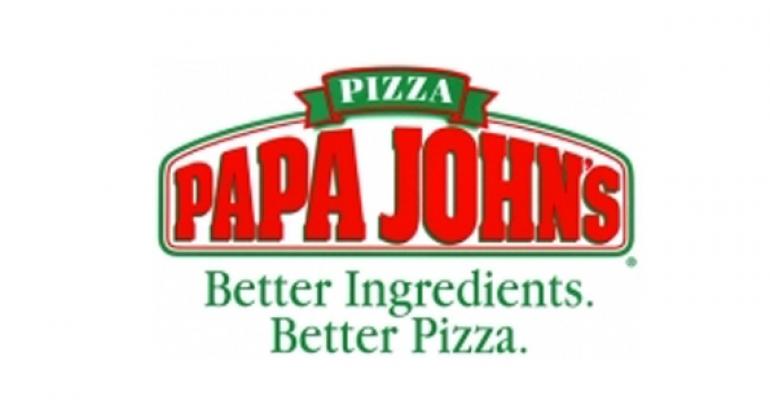Citing growth in third-quarter profit, revenue and same-store sales, Papa John’s International Inc. raised its guidance for 2012 earnings and sales trends, even as officials warned that commodity inflation and a competitive pizza segment would intensify.
Louisville, Ky.-based Papa John’s now believes its annual earnings per share should rise to a range between $2.53 and $2.63, reflecting new same-store sales growth projections of between 3 percent and 4 percent in North America and between 6 percent and 7 percent for its international system. A year earlier, Papa John’s reported earnings per share of $2.20.
RELATED
• Papa John's to give away two million pizzas during NFL season
• Papa John's renews franchisee incentive program
• More restaurant industry finance news
“We have a guidance that we feel is realistic and attainable,” chief financial officer Lance Tucker said during a conference call with investors. “We are going to see a fairly difficult commodity environment in the fourth quarter — you can look at the cheese futures and see that — as well as continued difficulty in the competitive environment. … We’re happy with where we are in our momentum, but we want to make sure that we stay competing the way we are.”
Sales, earnings soar in Q3
For the Sept. 23-ended quarter, Papa John’s reported an 18.2-percent increase in net income to $13.2 million, or 55 cents per share, from $11.1 million, or 44 cents per share, posted in the same quarter a year earlier.
Latest-quarter revenue rose 6.5 percent to $325.5 million.
Same-store sales rose 2.5 percent in North America, reflecting gains of 5 percent for company-owned restaurants and 1.7 percent at franchised locations. In Papa John’s international system, same-store sales increased 6.9 percent. During the quarter, the pizza chain broke the 4,000-location threshold.
Steve Ritchie, the brand’s senior vice president of North American operations, noted that variability between company and franchised same-store sales would continue, but founder and chief executive John Schnatter expressed confidence that the brand’s franchisees would begin to catch up to the corporate operators’ performance.
“[The franchisees have] kind of found religion,” Schnatter said. “They’re coming to us and going, ‘Hey, what are you guys doing?’ We didn’t get here by what we did this quarter; we got here with what we’ve been doing the past three, four, five years. So they’re starting to come on line and do things the way corporate is doing them, and we think we’re going to see a lot of good things in the near short term with our franchisees.”
Pricing flexibility next quarter, next year
Papa John’s franchisee advisory council soon will decide whether it joins the corporate system in hedging its commodity costs for cheese against the inflation that brand officials predict in the fourth quarter. Schnatter and his executive team reiterated that the company would manage through any sort of competitive or commodity environment by sticking to its operations fundamentals and what it calls its quality-leader positioning built by its longtime “better ingredients, better pizza” message.
“When sales are not quite as good as we’d like, we say, ‘OK, what could we do from product quality and service,’ and go back to our fundamentals,” Schnatter said. “What can we do from a local-store marketing perspective? What can we do to go out and hustle a little bit to build things? Then we may take a look at our digital marketing to make sure that it’s on track.”
Chief marketing officer Andrew Varga added that sales from online and mobile ordering exceed 35 percent of Papa John’s total sales in North America and that the brand’s ongoing sponsorship tie-in with the National Football League continues to pay dividends.
He and Schnatter also noted that the brand’s “better ingredients, better pizza” positioning would afford the chain some flexibility to increase prices if warranted by commodity pressure in the near term.
“We are probably in the best position with our quality advantage to take price,” Schnatter said. “The nice thing about our situation is we do make a better pizza, and people notice that and like us better. We own that positioning, and that puts us on the high ground.”
He added that Papa John’s fortunately does not “operate in a vacuum.”
“Whether it’s McDonald’s or Texas Roadhouse, or our two leading competitors [Domino’s and Pizza Hut], if we’re feeling the pressure to have to take price, then they’re going to have to feel the pressure to take price,” he said, “and I think all ships will have to rise in that environment.”
Remaining the “premium and quality leader” is most crucial, regardless of the market for commodities, Varga added.
“We have substantiated that significantly over the last two years by taking price regardless of what the commodity environment was throwing at us,” he said. “But we also look at it from a consumer perspective, and we have to push as far as we can to make sure that we’re getting as much value for ourselves and the consumer at whatever price point we have.”
In North America, Papa John’s operates 643 company-owned stores and franchises another 2,513 units. Its international system comprises 873 stores in 34 countries.
Contact Mark Brandau at [email protected].
Follow him on Twitter: @Mark_from_NRN

